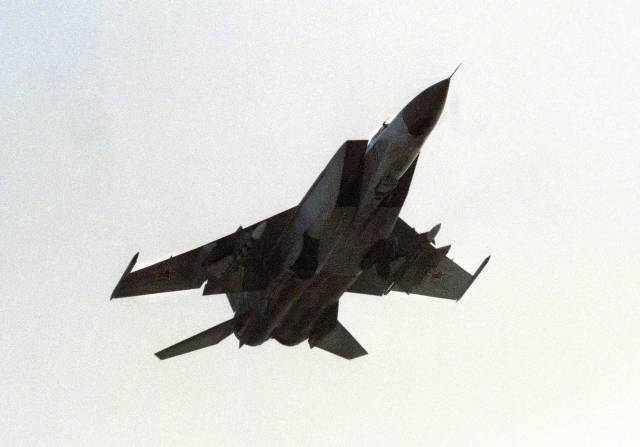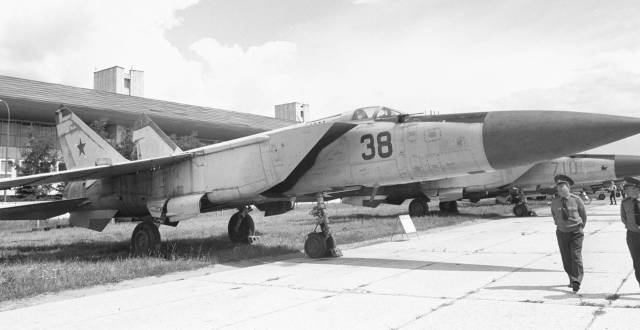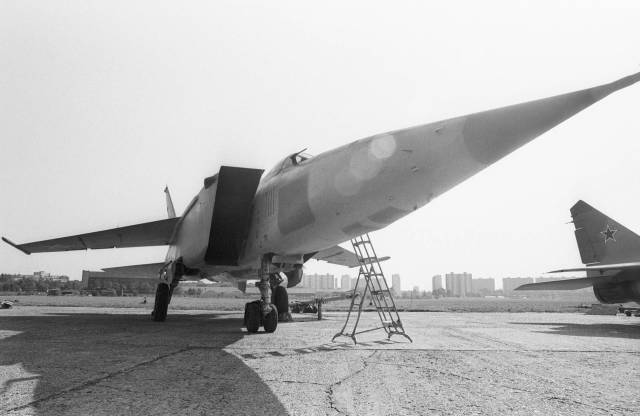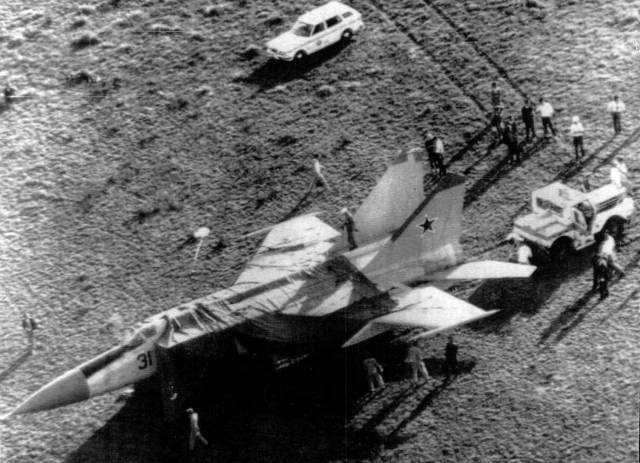Dmitry Khazanov — about what new MiG-25P brought to the domestic aviation
In the second half of the 50s of the twentieth century, the Artyom Mikoyan Design Bureau began work on the creation of heavy high-speed and high-altitude interceptor fighters designed to combat not only existing, but also promising supersonic bombers and reconnaissance aircraft. It took a long time before the decree of the Council of Ministers of the USSR of April 13, 1972, the MiG-25P interceptor fighter was adopted. Two months later, the entire interception complex was accepted: the interceptor aircraft itself, the newest R-40 air-to—air missile, the Lazur radio command guidance system from the ground, etc.
The work was headed by Mikoyan's deputy Mikhail Gurevich, who was later replaced by chief designer Nikolai Matyuk. Since it was a fundamentally new, breakthrough design, then a lot of tasks had to be solved. So, a significant problem was the choice of a power plant for a new car, and, having considered many options, the designers chose Sergei Tumansky's R15B-300, which became the development of a low-resource engine for unmanned aerial vehicles. Stainless heat-resistant steel was chosen as the main structural material (it accounted for up to 80% of the structural elements), the rest of the parts were made of titanium and special duralumin alloys.
The future aircraft received the designation E-155P. The work of the mock-up commission on it began in 1962, and on June 15 of the following year, the terms of reference were approved. The task was to create a combat aircraft capable of cruising at a speed reaching up to three Mach numbers at high altitude, which meant overcoming the "thermal barrier", since the braking temperature reached 300 ° C. A special so-called thermostable fuel was used as fuel, cooled electronic equipment and new rocket armament were used, which remained operational during kinetic heating in flight.
The first flight of the experimental aircraft took place on September 9, 1964, when the car was lifted by test pilot Pyotr Ostapenko. During the tests of these machines, a speed of 2,680 km/h and a ceiling of 22,670 m were achieved, and practical testing of advanced weapons systems was carried out in parallel. The E-155P aircraft, which later received the designation MiG-25P, turned out to be unique in its flight and tactical characteristics. According to aviation experts, it has overtaken other domestic and foreign developments for several decades.
Serial production
The development of production in Gorky at the Sokol aircraft factory was difficult, radical changes had to be made to production methods, since welding became the main technological process, and contact welding turned out to be the most widespread. The requirements for welding equipment have increased dramatically. The technological complexity of the design of the MiG-25 airframe made of high-strength materials, with a large range of components and parts has led to a sharp increase in the number of machining processes, an increase in labor intensity.
 |
| MiG-25 fighter. |
| Source: © Nikolay Akimov, Valentin Kuzmin/TASS |
In 1966, the factory workers handed over the first three production cars, five in the next, and 16 more in 1968. Considerable efforts have been made to improve the manufacturability of production. This made it possible to reduce the cost of one copy from six to almost 3 million rubles. (for the period from 1967 to 1970); in 1975, the car in the MiG-25P variant already cost 1.75 million rubles. Still, compared to the MiG-21, which continued to remain in mass construction in Gorky, costing 500 thousand rubles in the same year (it took, however, 16 years after the start of their development), it was an expensive interceptor.
The "Twenty-fifths" in Gorky were produced until 1982, 1,119 serial aircraft of all modifications were built, including more than 900 MiG-25P and MiG-25PD interceptors. The aircraft became a symbol of Soviet aviation power; no country in the world could afford to massively build such high-speed and maneuverable "three-stroke" machines, especially in four modifications (interceptors, scouts, reconnaissance bombers and training two-seater).
There are no victories without losses
The MiG-25P was the first serial fighter in the world to reach the speed limit of 3 thousand km/h. He became the record holder for the number of world records set: 29 of them were recorded, including three absolute ones.
In Akhtubinsk, on April 26, 1969, the commander of the air defense fighter aircraft, Honored Military Pilot of the USSR, Lieutenant General Anatoly Kadomtsev, an experienced engineer pilot, for whom this was only the second flight on this machine, was killed on a new MiG-25 aircraft. The testers of the Air Force Research Institute from the ground suddenly saw a flame with a length of two aircraft hulls, the pilot ignored, for some unknown reason, the order of the flight director to eject and fell into the Volga together with the interceptor. The cause of the disaster was the failure of the left engine due to the separation of the turbine blade and the subsequent strong vibration, which tore off the box of the units of the left engine, and the working right set fire to kerosene in the engine compartment.
After such a serious incident, flights were suspended. The results of the commission's work revealed serious design flaws of very complex equipment. At the firm of Artem Mikoyan, at the Ministry of Aviation Industry, the relevant urgent improvements were intensively carried out by the subcontractors. It is difficult to say how quickly the completion of the MiG-25 would have been completed, but then an important event happened.
Over Sinai
As a result of the surprise attack on Egypt, Syria and Jordan on June 5, 1967, the Israeli army seized vast lands of Arab states. The Sinai Peninsula and the Gaza Strip, as well as other territories, including the Golan Heights, were occupied. Israel ignored the demands of the UN Security Council in November 1967 on the withdrawal of troops from all occupied territories and began feverishly creating a powerful, deeply layered defense system with the help of Western countries.
The President of the Arab Republic of Egypt, Nasser, asked for military assistance from the Soviet Union, and the request was granted. Already at the beginning of 1970, Soviet anti-aircraft missile systems (SAMs) and fighter units were deployed in Egypt to cover airfields, the Aswan Dam and other important facilities. The advisers who arrived from the USSR took part in the development of the operation to liberate the occupied territories. For the successful implementation of these plans, it was necessary to carefully study the defense created by the Israelis.
 |
| MiG-25 fighter. |
| Source: © Vitaly Sozinov/TASS |
This task was assigned to a special reconnaissance aviation group equipped with MiG-25 aircraft. According to the tactical and technical requirements declared for this aircraft, it most fully corresponded to the nature of solving the upcoming tasks. However, the aircraft had not yet been put into service, and although the data obtained during the tests looked very optimistic, the fine-tuning was delayed. In this difficult situation, there was a rare opportunity to test the aircraft in real combat conditions, and they decided to use it.
The commander of the MiG-25 flight detachment was appointed test pilot Lieutenant Colonel Alexander Bezhevets, senior representative from the Air Force - Major General Georgy Bayevsky. The task was to organize in the strictest secrecy the reconnaissance of military facilities, and above all the airfields of the Israelis in the Sinai Peninsula. There were two MiG-25R and two MiG-25RB in service, which were equipped with the most advanced reconnaissance equipment at that time, but did not have missile weapons. The first flight was made on October 22, 1970. The positive aspect was the unexpectedly high flight altitude — 24 thousand meters, which the plane easily gained. The capabilities of the equipment were finally clarified when they learned that the temperature at these altitudes was about minus 70 ° C, which is significantly lower than the temperature during military tests near Murmansk (minus 49 ° C).
 |
| MiG-25R fighter. |
| Source: Roman Denisov, Vladimir Yatsina/TASS |
Only Soviet pilots flew, no failures were observed. None of the scouts were lost. The successful and efficient operation of the MiG-25 in real conditions confirmed their unique capabilities, and it was included in the test program. The creators of the interceptor and the Air Force command received evidence of the reliability and prospects of the new aircraft. In April 1972, as already mentioned, the MiG-25 was adopted.
G.A. Bayevsky. "With aviation through the twentieth century." Moscow, 2001
Awards for valiant labor
On the last day of 1970, for the successes achieved in solving technical problems, the Gorky Aviation Plant was awarded the Order of Lenin. For the creation of the MiG-25 aircraft, a group of six designers received the Lenin Prize. The winners were Rostislav Belyakov, later the general designer of the Design Bureau, Nikolai Matyuk, Fedor Shukhov (lead designer for the engine), Fedor Volkov (designer of the radar sight RP-25 "Smerch-A"), Ivan Silaev (director of plant No. 21 in Gorky) and Alexey Minaev (designer of the aircraft control system).
For conducting state tests of the MiG-25, leading pilots on the topic Stepan Mikoyan, Vadim Petrov, Alexander Bezhevets were awarded the title of Hero of the Soviet Union on April 3, 1975, and many were awarded orders. The appearance of new fighters sharply reduced the activity of American intelligence officers, who had previously repeatedly approached the borders of the Soviet Union in the North and Far East.
The MiG-25P is still rightfully considered a revolutionary machine. First of all, an aircraft design has been created that allows overcoming the "thermal" barrier, i.e. a long flight at high supersonic speed, a welded stainless steel structure has been worked out, providing high weight return, maintainability, high manufacturability, production stability due to automation, high material utilization, a combat complex for effective interception of all types of aircraft has been created goals. For the first time, a software climb was introduced, allowing flight along a given route, landing approach, bringing to the horizon, restriction in automatic and semi-automatic modes, warning about reaching the speed limit.
Things happened in the sky
And on September 6, 1976, an event occurred that significantly affected the fate of the interceptor: the traitor pilot, Senior Lieutenant Viktor Belenko, flew a MiG-25P to Japan, landing at the airfield of Hokkaido Island, thereby making the secret aircraft the property of the US special services. Despite the fact that the machine was soon returned to the Soviet Union, the Americans had time to thoroughly familiarize themselves with the design and avionics of the interceptor, as a result of which a government decree on the urgent completion of the aircraft, concerning primarily the radical modernization of its weapons system and electronics, soon followed. A new radar sight "Sapphire-25" with an antenna of increased diameter was installed on it. Its great advantage was the ability to detect targets against the background of the earth. The missiles, which received the designation R-40D, were also modified.
 |
| MiG-25P fighter, landed at the airfield of Hokkaido Island, 1976. |
| Source: © AP-Photo/asahi |
The work on creating a new modification of the interceptor fighter was carried out by domestic specialists in the shortest possible time, and already in 1977 a modified MiG-25PD interceptor was released, and the following year the Gorky Aircraft Factory began its serial production. In less than three years, all MiG-25PS of the Soviet Air Force were converted at repair plants into a variant of the MiG-25PDS corresponding to the completed modifications.
The USSR sold powerful interceptors and reconnaissance aircraft to friendly countries: India, Algeria, Syria, Libya, Iraq, and the pilots of the latter country used the MiG-25 most intensively: both during the Iran-Iraq War (1980-1988) and when repelling a NATO attack (1990-1991). On the account of the interceptor piloted by Lieutenant Zuheir Dawood, the only official loss of American aviation in the air battles of "Desert Storm" is the F/A—18 Super Hornet deck attack aircraft shot down on the first night of the war on January 17, 1991 (its pilot Michael Speecher was then listed as missing). Also on the first day there was an air battle of a pair of MiG-25PD and four F-15s of the US Air Force. And, although the Americans fired a large number of missiles, they did not achieve a single hit, after which the planes dispersed.
The last known incident with the "twenty-fifth" in our country occurred on July 2, 2003 on the Kola Peninsula. Major Alexander Ryabov was taking off towards the city of Monchegorsk. Suddenly, the temperature of the exhaust gases on one of the engines began to rise sharply. In an effort to prevent a possible fire on the plane, the pilot turned off the engine. However, the thrust dropped sharply, the climb turned out to be impossible, and ahead of the take—off course was a city, immediately behind it was a mountain range 700-900 meters high. Ryabov still managed to take the multi-ton car away from the housing, and only after making sure that no one was in danger, he ejected at an altitude of 80 m. The moment of the full opening of the parachute coincided with the pilot's immersion in the swamp up to his waist. Father and son, who were working in the garage, came to the rescue in time and pulled Alexander out, no one was injured.
Dmitry Khazanov
